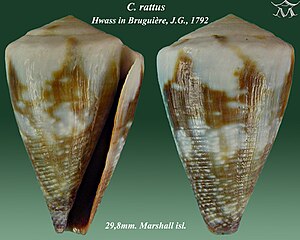Rat cone
| Rat cone | ||||||||||||
|---|---|---|---|---|---|---|---|---|---|---|---|---|

Enclosure of Conus rattus |
||||||||||||
| Systematics | ||||||||||||
|
||||||||||||
| Scientific name | ||||||||||||
| Conus rattus | ||||||||||||
| Hwass in Bruguière , 1792 |
The rats cone or rat cone shell ( Conus rattus ) is a screw from the family of the cone snails (genus Conus ), which in Indopazifik is used and from Vielborstern fed.
features
Conus rattus carries a moderately small to moderately large, moderately firm to firm snail shell , which in adult snails reaches 3 to 6 cm in length. The circumference of the body is conical or bulbous conical to broad and sometimes broadly conical, the outline in the third to three-quarters of the apex alternately convex, the left side concave towards the base. The shoulder is angled. The thread is low with medium high, its outline is slightly convex to concave. The Protoconch has three or more whorls and measures a maximum of 0.6 to 0.8 mm. The seam ramps of the Teleoconch are flat with 2 to 3 to 3 to 6 increasing spiral grooves. The body is at the base with alternately protruding, fine, spiral ribs, but the sculpture fades towards the apex.
The basic color of the housing is bluish-white to grayish-blue. The area around the body is covered with various olive, brown or orange-brown shades, which leave a wide, interrupted spiral band in the basic color on the shoulder and another, decrepit to wide band in the middle. Continuous dark brown, spiraling lines can extend from the base to the area near the shoulder. In some places around the body, brown spiral lines are broken down by white dots and appear speckled as a result. There are both uniform brown housings and shells with numerous white dots and spots. The base is purple or dark brown. The whorls of the Protoconch and adjacent seam ramps of the first whorls of the Teleoconch are often pale yellow, while later seam hitchhikes have olive or brown radial markings on a white background. The inside of the case mouth is purple and, in the case of large specimens, has alternating white further inside.
The alternately thick, translucent to opaque, smooth or on the circumference of the body on the spiral ribs covered with tufts at alternating intervals is yellow to olive-colored.
The snail itself is solid black or olive with black spots. The top of the foot may have short diagonal rows of white dots in each of the front corners. The sole of the foot, the rostrum and the antennae can be lighter, the sipho darker than the foot.
The radula teeth, which are connected to a poison gland , have a barb at the tip and a long cutting edge on the opposite side, to which the tooth is sawed parallel. A single spur sits at the base.
distribution and habitat
Conus rattus is distributed throughout the Indo-Pacific from the Red Sea and Tanzania via Madagascar , Chagos , Aldabra and the Mascarene Mountains to Polynesia and Australia ( Northern Territory , Queensland , Western Australia ). It lives in the intertidal zone and below to a depth of about 15 m, both in exposed and protected areas on limestone from corals with or without algae growth or areas with sand, often hidden under rocks, sometimes also on gravel, rubble or in crevices .
Development cycle
Like all cone snails, Conus rattus is sexually separate, and the male mates with his penis . Off Sri Lanka and the Seychelles , the female lays in irregular clusters about 8 to 15 mm long and 5 to 11 mm wide egg capsules in 15 cm to 1.5 m water depth on the underside of coral rocks on basal plates. Each capsule contains about 2000 to 7500 eggs with a diameter of about 124 to 175 µm. From this it is concluded that the Veliger larvae swim freely for at least 26 to 30 days before they sink down and metamorphose into crawling snails .
nutrition
The prey of Conus rattus consists of many bristles , according to studies on coral reefs in Thailand and Indonesia in particular from the families Eunicidae and Nereididae , which it pricks with its radula teeth and immobilizes with the help of poison from the poison gland . The poison is strong against poly-bristles and less strong against small fish, but does not harm mice.
literature
- George Washington Tryon: Manual of Conchology, structural and systematic, with illustrations of the species , vol. VI; Academy of Natural Sciences, Philadelphia 1884. C [onus] rattus Hwass., P. 41.
- Jerry G. Walls: Cone Shells: A Synopsis of the Living Conidae TFH Publications, Neptune (New Jersey) 1979. p. 826.
- Dieter Röckel, Werner Korn, Alan J. Kohn: Manual of the Living Conidae Vol. 1: Indo-Pacific Region . Verlag Christa Hemmen, Wiesbaden 1995. The texts on the individual cone snail species of the Indo-Pacific are published on The Conus Biodiversity website with the permission of the authors (see web links).
Web links
- The Conus Biodiversity website: Conus rattus Hwass in Bruguière, 1792
- Underwater Kwajalein: Conus rattus Linnaeus, 1767
- Conus rattus eats a poly-bristle ( Lumbrineridae ): overall picture , close-up , almost completely eaten
Individual evidence
- ↑ Alan J. Kohn, James W. Nybakken (1975): Ecology of Conus on eastern Indian Ocean fringing reefs: diversity of species and resource utilization. Marine Biology 29, pp. 211-234.
- ^ Robert Endean, Clare Rudkin (1965): Further studies of the venoms of Conidae. Toxicon 2 (4), pp. 225-249.